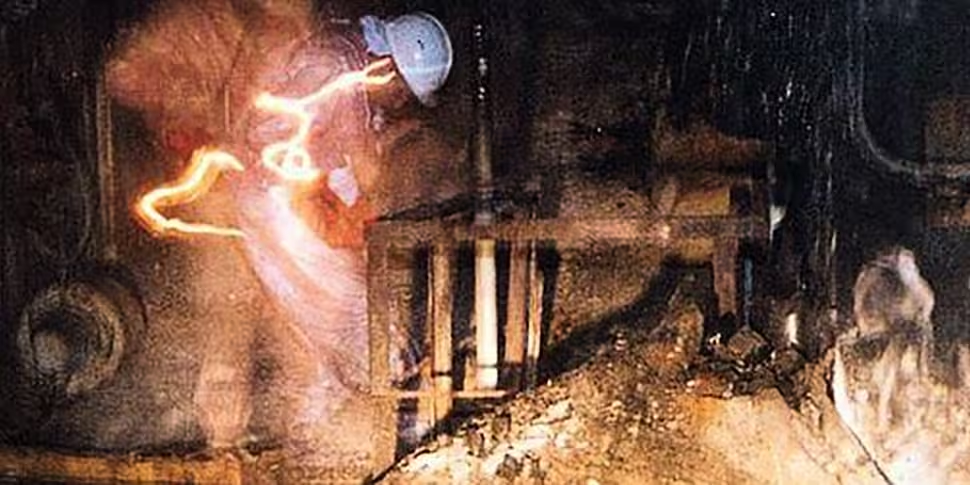If you spent just two minutes beside the lumpy pile, a mixture of nuclear fuel, melted concrete, sand, and the melted metal that had once shielded the whole mass, the cells in your body would start draining. Double the exposure, and you’d start to throw up, experience diarrhoea and run a burning temperature. Stick around for another 60 seconds, and within 48 hours you’d be dead. It’s the Elephant’s Foot, the most dangerous relic of the Chernobyl disaster and the site of the world’s most brazen selfie.
Today marks the 30th anniversary of the world’s most infamous nuclear accident, a series of explosions at the reactor of a Soviet facility in Ukraine. In the early hours of the morning, a test ran awry, resulting in an uncontrolled explosion that blasted the roof off the building, a toxic radioactive smoke billowing into the sky, drifting nuclear fallout across the USSR and northern Europe.
For ten days, radiation from the site’s fourth reactor escaped into the environment, requiring more than 250,000 people to be removed from their homes for safety. Officially, the death toll stands at 31, mostly accounting for the clean-up workers tasked with containing the disaster. But thousands more have died over the years, with a notably higher proportion of patients presenting with rare cancers or birth defects. A 30km exclusion zone is still in place around the reactor, reclaimed by the earth as a vibrant ecosystem – and by Ukrainian tour operators as a tourist hotspot for the curious visitors who flock in their thousands to the abandoned town of Pripyat.

One of the first images of the Elephant's Foot, captured by workers who pushed a camera on a chair around a corner to see what was causing the massive radiation spike [Imgur]
Months after the disaster, Ukrainian crews working on the containment finally broke into the steam corridor located beneath the molten remains of Reactor No. 4, their radiation readers making it clear that what was inside was something to be avoided. Poking cameras around the corner, they got their first glimpse of a black sludge that had seeped its way through a pipe meant for steam. Still burning hot, the oozing silt had formed a large deposit, which the workers quickly named the Elephant’s Foot.
To say this mass of hardened slime was toxic was to avoid the elephant in the room; reports from the Chernobyl site suggested that the pile was emitting 10,000 röntgens an hour, the same exposure as more than 4.5m chest x-rays. A decade later, it was still highly dangerous to be around, making Artur Korneyev’s Elephant Foot selfie one of the world’s most incredible.
A Kazakh nuclear inspector with a deadpan sense of humour, Korneyev (as identified by Atlas Obscura, though other spellings of his name exist), has been trying to tame the Elephant’s Foot since its discovery, educating people about its formation and the dangers it still poses to Ukraine.

Originally designed to vent steam, when the No 4 reactor experienced meltdown, the molten nuclear fuel melted concrete and sand, seeping through the pipe network below [Imgur]
Having visited the foot hundreds of times, Korneyev’s job in the initial aftermath was to find the fuel deposits leftover after the core meltdown – a task that saw him sometimes having to kick pieces of fuel out of his way as he worked through the steam tunnels.
Immediately after the disaster, the Soviet authorities worked on constructing a massive concrete structure around the site, hoping to contain the radioactivity. Hastily designed, this has become known as the Chernobyl Sarcophagus, made of more than 430,000 cubic metres of concrete and 7,300 tonnes of metal. Within a few short years, it was already falling apart – with Korneyev repeatedly making his way inside to research the Elephant’s Foot and the material it is made of, dubbed by scientists as Corium.
Now in his late 60s, Korneyev no longer visits the Elephant’s Foot, having been banned after years of irradiation. But the photograph of him standing beside the Corium spewing from the pipe remains one of the most interesting images of the Chernobyl disaster. Believed to be a timed self-portrait, the picture’s development shows an otherworldly environment. With the slow shutter speed, allowing Korneyev to get into the frame, it looks like he is moving and explains why the lightbulb from his torch sparks like forked lightning. The images graininess, according to journalist David Goldenberg, is most likely a direct result of the radiation.
As well as bringing journalists from around the world to see the Elephant’s Foot, Korneyev’s commitment to Chernobyl can best be exemplified by the fact that he was among the first people to alert the world’s media to the dangerous decay of the sarcophagus. When interviewed by The New York Times in 2014, he was helping in the construction of the colossal $100m arch that should finally be finished next year and will seemingly contain the radioactivity for 100 years.
The radiation will, of course, outlast that. “Soviet radiation,” Korneyev quipped, “Is the best radiation in the world.”









